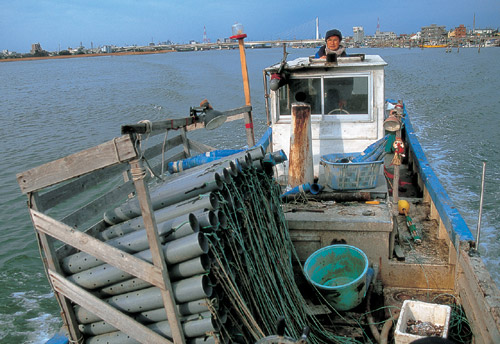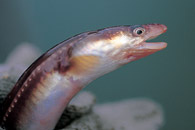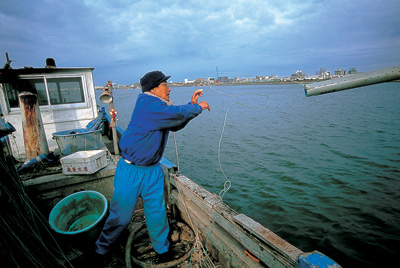 |
|
NIPPONIA No.21 June 15, 2002
|
|
Special Feature*
 |
|
Ito's boat is called the Yasuda-maru. Guided by instinct and many years of experience, he sets off to look for a place where there are lots of sea eels.
|
|

One sea eel he caught. They taste best when they are about a year old.
|
Now it's 2 p.m., and he hums as he sets out from the port alone with 230 traps, all baited. He's heading for a place where he expects the water on the bottom to be about 10°C, because sea eels are most active around that temperature. The rule of thumb is to place the traps quite deep in the summer, and quite shallow in the winter. Ito has been at this long enough to go by experience and hunch, more than anything else. When he finds a spot to his liking, he drops the traps one by one into the water. They are tied by a rope to each other, and he marks their position with a buoy. At around 4 p.m., he heads back for port.
Ito is the head of the ota Fishing Co-operative, which has a membership of 70 fishermen. After he gets back to port, he works for the co-op, attending meetings, getting things done on the phone, and so on. He's 67, but he's one of the younger co-op members—most are getting on in years and have nobody to buy their businesses.
The next morning at 5 a.m., he sets out into the bay again to get his catch. He hauls in the rope, looking inside one trap after another. He tosses the sea eels into a tank at the bottom of the boat, where they can stay alive. When his harvest is in, he steers the boat back home for breakfast. Then, he has time to relax and watch TV until 10 a.m.
The sea eels are sent to a distribution center in central Tokyo, or shipped directly to restaurants. Sea eels from Tokyo Bay are prized for their soft flesh, and fetch a good price. They are popular for sushi (not raw, though) and tempura.
"Sometimes I catch a lot, sometimes not even one. They are part of the natural environment, so you get what you get. That's what makes fishing interesting. If you can't stay optimistic on bad days, you won't last long in this business."
When his catch is poor, he tries harder. When it's good, he tries to make it better. Almost every fisherman he knows has back pain, perhaps because of all the physical labor and the cool, wet sea air. Ito had a hernia operation recently, and has only just recovered.
"The best thing about sea eel fishing is looking for where there are lots of them. When a hunch turns out right and the catch is big, I'm on top of the world and proud of myself!"
After half a century fishing, Ito still follows his hunches, searching for sea eels, which are declining in numbers in Tokyo Bay. 

Ito throws his traps into the bay, one after the other. He drops 230 traps in the water, all tied together with 18 m of rope between each one. He'll use a machine later to pull them back up.
|
|
 |